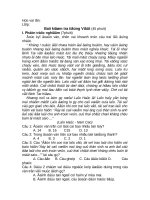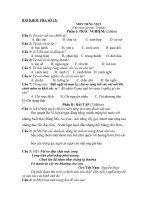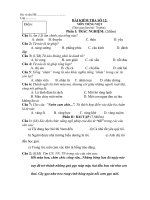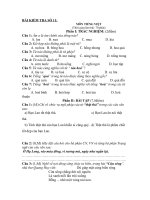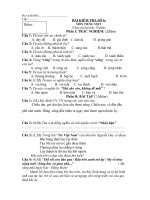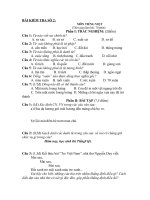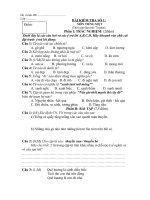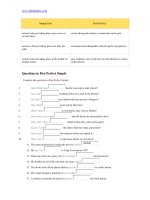Bài Kiểm Tra Ngữ Âm 2
Bạn đang xem bản rút gọn của tài liệu. Xem và tải ngay bản đầy đủ của tài liệu tại đây (69.57 KB, 8 trang )
Ngữ Âm 2
Câu 1: The beginning sounds of the syllable are called the .............
A. rhyme
B. coda
C. onset
D. nucleu
s
Câu 2: Which of the following pairs of words have different diphthongs?
A. dough - plough
B. mare - prayer
C. aisle - dyke
D. ace - gaol
Câu 3: The substitutability of one sound for another in a given environment, with
no change in the word’s meaning is called ...
A. distribution
B. free variation
C. a near minimal
pair
D. a minimal pair
Câu 4: Which of the following pairs of words have the same diphthong?
A. mayor - taylor
B. height - take
C. bourse mature
D. pure - future
Câu 5: The core or essential part of a syllable is called the ..............
A. coda
B. nucleu
s
C. rhyme
D. onset
Câu 6: Which of the following consonant clusters is impossible in English?
A. [skj]
B. [spw]
C. [spl]
D. [skw
]
Câu 7: Which of the following statements is TRUE?
A. In English and most other languages, most syllable nuclei are vowels.
B. Most speakers of English find it difficult to divide a word up into its
component syllables.
C. A syllable is a unit of sound composed of only a central peak of sonority.
D. The smallest possible syllable contains a nucleus and a coda.
Câu 8: Pairs of words which differ in one sound only and have different meanings
are called ...
A. near minimal
pairs
B. close pairs
C. minimal pairs
D. different pairs
Câu 9: Which of the following are described as [+ vocalic]?
A. Obstruent
s
B. Glides
C. Vowels
D. Liquids
Câu 10: ........... represent the placement of the body of the tongue.
A. Dorsal features
B. Laryngeal
features
C. Place features
D. Manner features
Câu 11: The word 'tomato' consists of ......
A. two syllables
B. one syllable
C. three
syllables
D. four syllables
Câu 12: Which of the following word lists has different vowels?
A. sought, tough, cough,
could
B. carpet, bath, hearth, aunt
C. suit, shoe, rule, route
D. push, wolf, should, pull
Câu 13: A phonetic transcription is also called a....
A. phonemic
transcription
B. broad transcription
C. narrow transcription
D. detail transcription
Câu 14: Which of the following is the description of the sound /i:/?
A. A more retracted front, short, lax, unrounded vowel
B. A front, short, lax, unrounded vowel
C. A front, close (high), long, tense, unrounded vowel
D. A lowest, front, short, lax, unrounded vowel
Câu 15: Which of the following consonant clusters is is example of "Coronal +
sonorant"?
A. [spw
]
B. [spl]
C. [str]
D. [skl]
Câu 16: The most important feature of a diphthong is that it ...
A. contains a glide from one vowel quality to another
one.
B. ends in /w/ and /u/.
C. is a combination of more than two vowels.
D. begins with /e/, /a/ or /o/.
Câu 17: Complementary distribution is an indication that the sounds in question
are ...
A. minimal pairs
B. phones
C. phonemes
D. allophones of the same
phoneme
Câu 18: A physical language sound, measurable by acoustic instruments is
called ...
A. a phoneme
B. a minimal
pair
C. a phone
D. an allophone
Câu 19: Which of the following word lists has the same vowel?
A. should, through, rule, route
B. could, routine, source,
journal
C. quay, each, people, key
D. many, fat, act, sad
Câu 20: Which of the following statements is NOT correct?
A. Syllables don't serve any meaning-signalling function in language.
B. Most speakers of English have no trouble dividing a word up into its
component syllables.
C. A word contains at least two syllables.
D. Syllables exist only to make speech easier for the brain to process.
Câu 21: A phoneme is put between ....
A. square boxes
B. square
brackets
C. slash brackets
D. round boxes
Câu 22: Contrastive distribution is an indication that the two sounds in question
are ...
A. different phonemes
B. allophones of the same
phoneme
C. different phones
D. similar phonemes
Câu 23: Which of the following is the description of the sound /Z/?
A. A central, mid, long, tense central
vowel
B. A short, lax, open and slightly rounded
C. A front, short, lax, unrounded vowel
D. A long, tense, rounded vowel
Câu 24: Which of the following statements is NOT correct?
A. Phonemes vary from language to language.
B. Allophones are unpredictable.
C. You never hear same phone twice.
D. Phonemes are abstract sounds stored in our
memory.
Câu 25: Which of the following words is English or possible in English?
A. pim
k
B. pimd
C. pim
b
D. pimt
Câu 26: In the following words which underlined letter is pronounced /i:/?
A. tick
B. machin
e
C. minute
D. win
Câu 27: In making these vowels: /w/, /i:/, , /u:/ space between the tongue and the
roof of the mouth is.......
A. relatively
narrow
B. very narrow
C. relatively wide
D. very wide
Câu 28: The following statement describes which aspect of vowel classification?
"Vowels are classified in terms of how much space there is between the tongue
and the roof of the mouth".
A. lip rounding
B. tongue
backness
C. vowel length
D. tongue height
Câu 29: Which of the following is NOT a minimal pair?
A. rat - sad
B. cat - sat
C. sad - sat
D. rat mat
Câu 30: The syllable structure of the word "strength" is ..........
A. CCCVCC
B. CCVCC
C. CVCC
D. CCCVC
Câu 31:
The sounds /w/ and /æ/ are examples of ...
A. back vowels
B. unrounded
vowels
C. long vowels
D. rounded vowels
Câu 32: Which of the following statements is NOT correct?
A. The rhyme may consist of only the nucleus.
B. The rhyme never precedes the onset.
C. The rhyme may consist of a nucleus and a coda.
D. The rhyme may consist of an onset and a
nucleus.
Câu 33: Allophones are ...
A. in complementary distribution
B. language sounds as they are perceived by a
speaker
C. physical language sounds
D. similar to phonemes
Câu 34: The sounds /i:/ and /u:/ are examples of ... .
A. back vowels
B. lax vowels
C. short vowels
D. tense
vowels
Câu 35: Phonemes are ...
A. organizable
B. predictable
C. concrete phonetic
segments
D. non-contrastive
